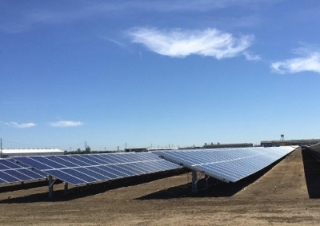Aug 27 2015
PSEG Solar Source today announced that it has acquired the Columbia Solar Project from Hanergy America Solar Solutions. The facility, built on a remediated brownfield, is located 40 miles northeast of San Francisco in Pittsburg, CA.
 The 25.4-MW PSEG Pittsburg Solar Energy Center is scheduled to go into service in October 2015.
The 25.4-MW PSEG Pittsburg Solar Energy Center is scheduled to go into service in October 2015.
The 25.4 MW-dc facility, to be named PSEG Pittsburg Solar Energy Center, is scheduled to go into service in October 2015 after the testing and commissioning process is completed. It has a 20-year power purchase agreement (PPA) with Pacific Gas & Electric.
"We are particularly proud to be part of this project that has turned a brownfield site green," said Diana Drysdale, president of PSEG Solar Source. "We continue to look for opportunities to build our business across the nation by working with best-in-class partners like Hanergy."
Solar Source has 12 facilities in operation or development with total capacity of 148 MW-dc.
The new facility has 83,000 solar panels on a 105-acre remediated parcel located in an historically industrial zone. The site underwent an extensive cleanup, led by site owner USS-POSCO Industries, over several years under the supervision of the California Department of Toxic Substances Control.
McCarthy Building Companies performed the engineering, procurement and construction for the project. Blue Oak Energy will operate the new solar facility. Hanergy America Solar Solutions completed the development and managed the construction of the Columbia Solar Project.
"We are excited to bring online the largest solar PV facility in the San Francisco Bay Area," said Pyramyth Liu, Chief Operating Officer of Hanergy America Solar Solutions. "The facility maximizes economic value of this brownfield site by providing clean energy for the surrounding communities. Hanergy looks forward to building many more large utility projects across the country with PSEG, a resourceful and reliable partner."
The energy produced at the facility will help PG&E meet California's mandate that 33 percent of the energy sold by investor-owned utilities must come from renewable resources by 2020.